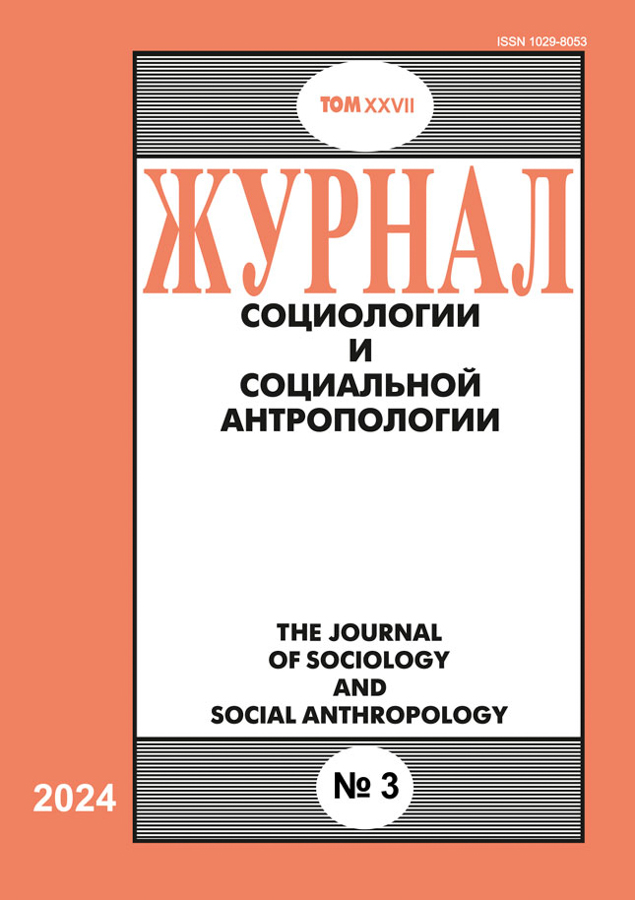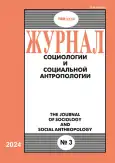Теоретические модели социально-цифрового неравенства (Э. Хелспер, И. Мариен): сравнительный обзор
- Авторы: Плотичкина Н.В.1
-
Учреждения:
- Кубанский государственный университет
- Выпуск: Том 27, № 3 (2024)
- Страницы: 7-38
- Раздел: Социальная теория
- URL: https://journal-vniispk.ru/1029-8053/article/view/273694
- DOI: https://doi.org/10.31119/jssa.2024.27.3.1
- EDN: https://elibrary.ru/GKOUUQ
- ID: 273694
Цитировать
Полный текст
Аннотация
Об авторах
Наталья Викторовна Плотичкина
Кубанский государственный университет
Email: oochronos@mail.ru
SPIN-код: 2719-4063
Кафедра государственной политики и государственного управления, доцент Краснодар, Россия
Список литературы
- Бурдье П. (2001) Практический смысл. СПб.: Алетейя.
- Бурдье П. (2005) Социальное пространство: поля и практики. М.: Институт экспериментальной социологии; СПб.: Алетейя.
- Гидденс Э. (2018) Устроение общества: очерк теории структурации. М.: Академический проект.
- Сен А. (2004) Развитие как свобода. М.: Новое издательство.
- Anrijs S., Mariën I., De Marez L., Ponnet K. (2023) Excluded from essential internet services: Examining associations between digital exclusion, socio-economic resources and internet resources. Technology in Society, 73: 1–11.
- Archer M.S. (2010) Morphogenesis versus structuration: on combining structure and action. British Journal of Sociology, 61(1): 225–252.
- Asmar A., Mariën I., Van Audenhove L. (2020) A qualitative analysis of the develop-ment of digital autonomy beyond the life course perspective. Brussels: Belgian Science Policy.
- Asmar A., Mariën I., Van Audenhove L. (2022) No one-size-fits-all! Eight profiles of digital inequalities for customized inclusion strategies. New Media & Society, 24(2): 279–310.
- Burchardt T., Hick R. (2018) Inequality, Advantage and the Capability Approach. Journal of Human Development and Capabilities, 19(1): 38–52.
- Calderon Gomez D. (2020) The third digital divide and Bourdieu: bidirectional conversion of economic, cultural, and social capital to (and from) digital capital among young people in Madrid. New Media & Society, 23(9): 2534–2553.
- Eynon R. (2023) Utilising a Critical Realist Lens to Conceptualise Digital Inequality: The Experiences of Less Well-Off Internet Users. Social Science Computer Review, 41(3): 1081–1096.
- Grenfell M. (ed.) (2008) Pierre Bourdieu: Key Concepts. L.; N.Y.: Routledge; Acumen.
- Helsper E. (2008) Digital inclusion: an analysis of social disadvantage and the information society. L.: Department for Communities and Local Government.
- Helsper E. (2012) A corresponding fields model for the links between social and digital exclusion. Communication theory, 22(4): 403–426.
- Helsper E. (2021) The digital disconnect: the social causes and consequences of digital inequalities. L.: Sage.
- Ignatow G., Robinson L. (2017) Pierre Bourdieu: theorizing the digital. Information, Communication & Society, 20(7): 950–966.
- Jones M.R., Karsten H. (2008) Giddens's structuration theory and information systems research. MIS Quarterly, 32(1): 127–157.
- Livingstone S., Helsper E. (2007) Gradations in digital inclusion: children, young people and the digital divide. New Media & Society, 9(4): 671–696.
- Mariën I. (2015) De Dichotomie van de Digitale Kloof Doorprikt: Een Onderzoek naar de Oorzaken van Digitale Uitsluiting en naar Strategieën voor een Duurzaam e-Inclusiebeleid. Doctoral Thesis. Brussel: Free University of Brussels.
- Mariën I., Baelden D. (2015) 8 profielen van digitale ongelijkheden [8 profiles of digital inequalities]. Onderzoeksrapport voor het federale onderzoeksproject IDEALiC.be. (Research Report for the federal research project IDEALiC.be.). Brussels: Belgian Science Policy.
- Mariën I., Heyman R., Salemink K., Van Audenhove L. (2016) Digital by Default: Consequences, Casualties and Coping Strategies. In: Servaes J., Oyedemi T. (eds). Social Inequalities, Media and Communication: Theory and Roots. Lanham: Rowman and Littlefield: 167–188.
- McGillivray D., Mahon J. (2021) Distributed digital capital: digital literacies and everyday media practices. Media Practice and Education, 22(3): 196–210.
- Merisalo M., Makkonen T. (2022) Bourdieusian e-capital perspective enhancing digital capital discussion in the realm of third level digital divide. Information Technology & People, 35(8): 231–252.
- Neves B.B., Waycott J., Malta S. (2018) Old and afraid of new communication technologies? Reconceptualising and contesting the ‘age-based digital divide.’ Journal of Sociology, 54(2): 236–248.
- Ragnedda M., Ruiu M.L., Addeo F. (2022) The self-reinforcing effect of digital and social exclusion: The inequality loop. Telematics and Informatics, 72: 1–13.
- Robinson L., Schulz J., McClain N., Hale T., Pait H., Ragnedda M. et al. (2020) Global perspectives on digital inequalities and solutions to them. First Monday, 25(7) [https://firstmonday.org/ojs/index.php/fm/article/view/10840/9560] (дата обращения: 20.06. 2023)
- Sallaz J.J., Zavisca J. (2007) Bourdieu in American sociology, 1980–2004. Annual Review of Sociology, 33(1): 21–41.
- Savage M., Warde A., Devine F. (2005) Capitals, assets, and resources: Some critical issues. British Journal of Sociology, 56(1): 31–47.
- Scheerder A.J., van Deursen A.J.A.M., van Dijk J.A.G.M. (2020) Taking advantage of the Internet: A qualitative analysis to explain why educational background is decisive in gaining positive outcomes. Poetics, 80: 1–12.
- Van Deursen, A.J.A.M., Helsper E.J. (2018) Collateral benefits of Internet use: Explaining the diverse outcomes of engaging with the Internet. New Media & Society, 20(7): 2333–2351.
- Zheng Y., Walsham G. (2021) Inequality of What? An Intersectional Approach to Digital Inequality under Covid-19. Information and Organization, 31(1): 1–6.
Дополнительные файлы











